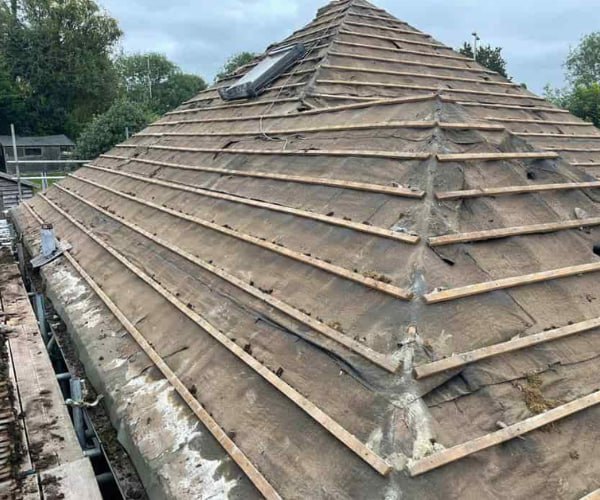The Secret to Preventing Leaks in a Steep Pitched Roof
A steep pitched roof is one of the most effective designs for managing rainfall in the UK’s unpredictable climate. Its angled structure allows water to drain efficiently, reducing the risk of pooling and damp. However, even with this advantage, leaks can still occur if the roof isn’t properly maintained or installed. At FCB Roofing Cranfield, we’ve seen how small oversights in steep roof construction or maintenance can lead to costly water ingress issues — but with the right knowledge and care, these can be avoided entirely.
Why Steep Pitched Roofs Are Both Strong and Vulnerable
Steep pitched roofs are designed to channel rainwater quickly off the surface, making them naturally resilient to moisture build-up. Their design also helps prevent debris accumulation, as leaves and dirt are more likely to slide off than stay lodged.
However, their very shape can make repairs and inspections more challenging. If flashing, tiles, or ridge lines are compromised, water can find its way into small openings. This means precision and attention to detail are essential during both installation and maintenance.
Common Causes of Leaks in Steep Pitched Roofs
Even the best roofs can develop leaks over time if certain issues are left unchecked.
1. Damaged or Slipped Roof Tiles
Tiles that crack or shift due to wind, frost, or ageing can create small gaps. These openings allow rainwater to penetrate the underlay and eventually reach the roof structure. On steep slopes, even a small displaced tile can cause significant water runoff issues.
2. Poor Flashing Around Roof Features
Flashing is one of the most crucial components of any pitched roof. If flashing around chimneys, vents, or dormers isn’t properly sealed or begins to deteriorate, it becomes a common entry point for leaks. Water naturally runs toward these junctions, making them particularly vulnerable.
3. Faulty Ridge and Hip Joints
The ridge is where two roof planes meet, and if ridge tiles or mortar joints become cracked or loose, they can quickly let in moisture. Because steep roofs experience greater wind uplift, these areas require extra attention.
4. Blocked Gutters and Valleys
While steep roofs shed water quickly, that water still needs somewhere to go. Blocked gutters or valleys can cause water to back up beneath the tiles, leading to damp or rotting timbers beneath. Regular clearing of these channels helps prevent water build-up and overflow.
5. Inadequate Underlay Protection
The underlay acts as a secondary barrier against water ingress. If it’s damaged or incorrectly installed, leaks can occur even when the tiles look intact. Over time, UV exposure and wear can also weaken this layer, especially on south-facing roofs.
The Secret: Precision, Sealing, and Regular Maintenance
Preventing leaks in a steep pitched roof comes down to three main principles — precision in installation, quality sealing, and routine maintenance.
1. Proper Installation and Tile Alignment
Every tile must be carefully positioned to ensure complete coverage. On steep slopes, gravity and wind can exert more pressure on the materials, so the tiles need to be securely fixed and correctly overlapped to form a watertight surface.
2. Effective Flashing and Joint Sealing
Attention to detail around roof intersections is key. Quality lead or alternative flashing, installed correctly and checked regularly, prevents water from finding entry points at joints and penetrations.
3. Regular Roof Inspections
Having your roof inspected by professionals ensures small issues are addressed before they worsen. A quick assessment after a storm or during seasonal changes can reveal potential problems like slipped tiles, cracked mortar, or blocked gutters that may otherwise go unnoticed.
4. Ridge and Verge Care
Because these are high-stress areas, ensuring the ridge and verge tiles are intact and well-pointed prevents wind-driven rain from seeping into the roof. Properly sealed ridges protect the entire structure from top to bottom.
Why Professional Maintenance Makes a Difference
While homeowners can spot visible damage from the ground, professional roofers can access and examine areas that are often overlooked. At FCB Roofing Cranfield, our team provides detailed inspections that focus on critical weak points — flashing, valleys, joints, and the underlay beneath your tiles. We understand the way steep roofs behave under British weather conditions and ensure every component is performing at its best.
Key Maintenance Tips for Homeowners
- Keep gutters and downpipes clear of debris.
- Check for visible tile displacement after strong winds.
- Trim back overhanging branches that can drop leaves or cause physical damage.
- Arrange professional roof inspections annually or after severe weather events.
Conclusion
A steep pitched roof offers beauty, durability, and excellent rain protection — but only when properly maintained. The secret to keeping it leak-free lies in regular inspections, precision sealing, and expert care from roofing professionals who understand the unique challenges of steep roof designs.
For reliable inspections, maintenance, and expert repairs across Cranfield and Bedfordshire, FCB Roofing Cranfield provides professional roofing services that keep your steep pitched roof watertight and performing at its best year after year.
Call us on: 01234 981 898
Click here to find out more about FCB Roofing Cranfield
Click here to complete our contact form and see how we can help with your roofing needs.

